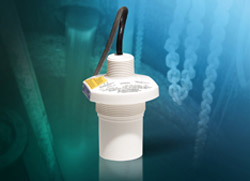Ultrasonic transducer measures liquid levels in corrosive atmospheres

This new material type improves the chemical compatibility of the ST-H transducer, offering more options for wet well, chemical storage, and process vessel applications.
When paired with a Siemens ultrasonic controller the ST-H transducer effectively measures the level of liquids in applications up to ten meters distance (33 feet) in conditions from -40 to +73 degrees Celsius (-40 to 164 degrees Fahrenheit). The transducer design includes both a 1 inch and 2 inch integral process connection. This allows easy mounting on varied vessels and wells. When installed using the 2 inch mounting threads, the only wetted parts are PVDF, providing excellent chemical immunity in corrosive atmospheres.
The ST-H transducer is impervious to dust, moisture, corrosion, vibration, flooding and temperature extremes. The non-contacting design virtually eliminates the nuisance, danger and expense of cleaning, adjusting and repair associated with contacting devices.
For technical details please contact:
Siemens Milltronics, Rob Niezen
rob.niezen@siemens.com
+1 (705) 740-7054
Media Contact
More Information:
http://www.siemens.com/levelAll latest news from the category: Machine Engineering
Machine engineering is one of Germany’s key industries. The importance of this segment has led to the creation of new university degree programs in fields such as production and logistics, process engineering, vehicle/automotive engineering, production engineering and aerospace engineering among others.
innovations-report offers informative reports and articles covering technologies such as automation, motion, power train, energy, conveyor, plastics, lightweight construction, logistics/warehousing, measurement systems, machine tools and control engineering.
Newest articles

Sea slugs inspire highly stretchable biomedical sensor
USC Viterbi School of Engineering researcher Hangbo Zhao presents findings on highly stretchable and customizable microneedles for application in fields including neuroscience, tissue engineering, and wearable bioelectronics. The revolution in…

Twisting and binding matter waves with photons in a cavity
Precisely measuring the energy states of individual atoms has been a historical challenge for physicists due to atomic recoil. When an atom interacts with a photon, the atom “recoils” in…

Nanotubes, nanoparticles, and antibodies detect tiny amounts of fentanyl
New sensor is six orders of magnitude more sensitive than the next best thing. A research team at Pitt led by Alexander Star, a chemistry professor in the Kenneth P. Dietrich…





















